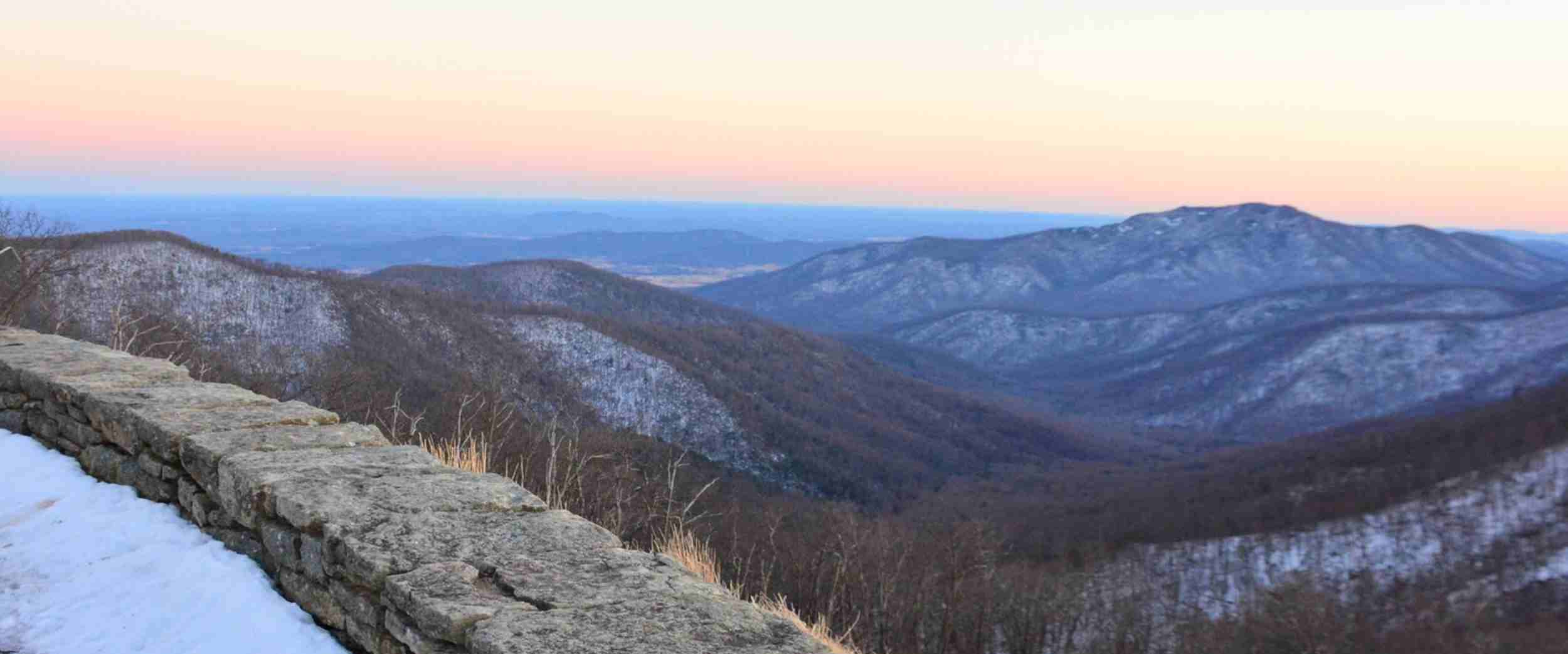by Patressa Kearns
Think it’s true that Shenandoah National Park is best visited in spring, summer, and fall? Think again. Yes, spring is life affirming here. Summer is a blast, and fall…well, fall is hard to beat, with its scarlets, oranges, and golds. But winter is also stunning in this national park. Like a snow-covered evergreen, Shenandoah National Park sparkles in winter!
There are plenty of reasons to visit Shenandoah in winter. Here are some of them:
12 Reasons to Visit in Winter
1) You’ll (sort of) have the place to yourself. All those hikes and overlooks you had to pass up when crowds were thick in May, July and October? Now’s the time! Old Rag Mountain and Dark Hollow Falls, Stony Man, and Hawksbill—you might see one or two other folks on the trail or at the overlook, but you’ll have plenty of room to spread out and linger a while at summits and waterfalls.
2) Winter sunsets are the best. You’d be hard pressed to find a prettier sunset in the world than the pastel ombre ones you’ll see from Hogback Overlook or Compton Peak. The orchid pinks, pale azures, and lavenders of January and February sunsets provide a light show you’ll remember forever.
3) No bugs! Well, very few. You’ll still want to check yourself for ticks after your hike (yes, ticks are around, even in January), but you won’t have to contend with – or swat at—gnats and flies. Snakes are in hibernation, so you can be a little less wary of them, too.
4) No sweat! Cold temperatures mean less perspiring. You might get your glow on, especially on an invigorating hike, but your clothes won’t stick to you the way they do in mid July.
5) Frozen waterfalls. Who doesn’t love a frozen waterfall? Even the mildly imaginative can find shapes in frozen springs and waterfalls—flying dragons, castles, polar bears, Mercury sprinting along his course.
6) Views are clear as crystal. Cold temps mean less humidity and less humidity means fantastic views. From overlooks and peaks, you’ll be able to see miles farther than you can the rest of the year—all the way to the Alleghenies to the west and almost to our nation’s capital to the east. Bring your binoculars.
7) Get to know trees, geology, and the shape of the land. Without their leaves, trees are more elegant and lithe, and shaped like the leaves they’ve shed. A hickory tree bears the silhouette of a hickory leaf, tulip trees the shape of tulip tree leaves. You can make out the shapes of rock outcrops, hills, hollows, and distant mountains and even try to identify them.
8) Feed your inner artist. Slow down. Notice how the sunlight dances off the frosty rock wall along Skyline Drive. Draw, paint, or photograph the details. Berries shriveled by the cold, a feather caught in a rock crevice, the convoluted way ice freezes in a small puddle. Even just getting out of your car at an overlook along Skyline Drive, you might find lacy patterns in the frost or snow. Perhaps the tatting of ice fairies?
9) Track wildlife. Snow means animal tracks. Look for wild turkey tracks, the unmistakable hoof prints of white-tailed deer, and perhaps the most charming of all, tiny mouse prints. In edges and open areas like Big Meadows, look under trees for owl pellets. You might even see the swoop marks made by the wings of hawks and owls, made when those birds of prey nabbed a mouse.
10) Be the first explorer. In winter, when crowds are non-existent, you can pretend you found these mountains before anyone else. When you round the turn on Bearfence Mountain Trail that opens up to that 360-degree view, make believe you’re the first person to see it! It’s amazing what a little adventuring can do for your spirit.
11) Have a winter picnic. Four of Shenandoah’s seven picnic grounds are open year round, including Pinnacles just south of mile 36 of Skyline Drive, which has a covered shelter. Bring your Thermos of hot cider and something warm and delicious to grill, and dine in the great outdoors. You’ll be amazed by how much hungrier you are in the cold weather—especially if you take a hike before your feast. And speaking of hiking…
12) Winter hiking is just better. It’s cold, yes, but more invigorating than hiking in the heat and humidity of summer. Be energized by all the little discoveries you’ll make. Like the way the winter sunlight plays on Marys Rock and turns it pink toward day’s end, the piney scent of evergreen needles crushing under your hiking boots, and the reprimanding croak of ravens at Hawksbill Summit.
